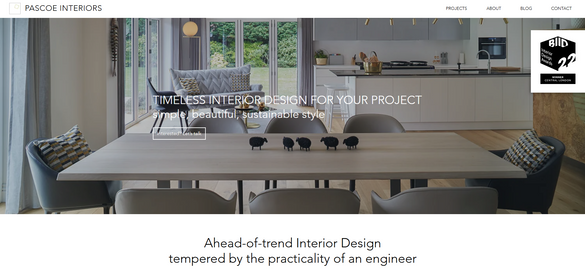 02 Nov 2024
02 Nov 2024
Award-winning interior designer Clare Pascoe is arranging the interview call from her West Sussex studio. “If the mobile doesn't connect, try Whatsapp – my studio is a pair of shipping containers which form a communications Faraday Cage. I'll have my chainmail suit at the ready!”. The scientifically precise reference is no accident – Pascoe's background is technical, having graduated in Design Technology and Business from the Engineering Faculty at Plymouth University (“a BSc not a BA course”). This brings a structural foundation to Pascoe's work and allows her to infuse the studio's projects with a passionately fact-based sustainability ethos.
Pascoe has been championing sustainable design for over two decades, and her own home is a former farmhouse, now covered in solar panels. Sustainability is an intrinsic part of family and work life for the designer. “My husband is a solar Photovoltaic installer, and we have a battery for storage set up.”
Pascoe uses her engineering knowledge to work technically, ensuring a project will work for the client. “To me the design is where are the walls, what can we change?”, Pascoe explains. “I look at the space in 2D black & white: the structure, the flow. People only notice bad plumbing or lighting, not good, so the most important thing is to get everything that's hidden working properly. Then, when we know what we're looking at, we can start 'colouring it in'.”
This meticulous method-based approach, along with the in-depth research style of a scientist, underpins Pascoe's commitment to sustainable practices. “As a designer, sustainability means creating interiors that are not only fit for purpose, while being ergonomically and aesthetically comfortable, but that will also stand the test of time.” The lifespan of a design is a key tenet for Pascoe's approach to sustainability. “Longevity is a two-pronged attack: how long can something physically last, and do we love it enough to keep it? Those are the main pillars of sustainability through longevity. I don't go for high fashion or a quick turnover. A design needs to be quite classic; it needs to stick. Then there are other considerations with products. Do we need it? Can we make do and mend an existing piece without it looking 'DIY'? You cannot put all the weight of your sustainable decision on its carbon footprint. It's more important that the product is fit for purpose and loved enough to keep for the long term.”
The pragmatic balancing of sustainable style and substance extends to Pascoe's choices of materials. “As a rule, I stress to my clients that we must not shy away from manufactured materials in the same way we do processed foods; with materials, blending modern manufacturing techniques with natural elements can increase the lifespan of their interior. A product might seem 'un-environmental' to produce if we look at its manufacture, components and transport alone. But if we consider how long it will remain beautifully fit for purpose, the scales begin to balance, tipping the product into the realms of sustainability through longevity.”
The work of her studio is predominantly residential, but Pascoe makes full use of the commercial design sector for products, materials and furniture that deliver the robust durability core to this principle of sustainability. “Commercial interiors, with their stringent fire retardant and wear requirements, demand products that legally must stand up to more rigorous use. Gone are the days when this resulted in a narrow range of choices – the commercial products sector is now huge, and bursting with beautiful products that can grace any high-end residential home.”
Pascoe works with a team to call on as needed including structural engineers, architects, contractors and a stylist, meaning the studio can do anything from a small job (“I have been called in to replace roller blind window treatments”) to substantial new builds or refurbishments. Whether large or small, all projects are approached with the core principle of far-sighted design made to last. At the initial design stage, Pascoe and her team plot out various furniture layouts to ensure the fundamental design elements can be switched with ease. “We get the basics done – the immoveable big things. Then it's healthy to stop and stand back. How we imagine we'd live in a home is not necessarily how we end up doing so. Situations change, children grow up.”
Interiors projects can be messy and disruptive, and often involve life's savings, and Pascoe's aim is always to minimise inconvenience and to contain costs. The ultimate objective though is to create a long-living design that 'belongs' to the homeowner. “I don't force my designs on people; it's not my home to create my own look for. I deliver spaces that I know can dynamically evolve, allowing our clients to make confident decisions they know will not restrict their options in the future.” Pascoe calls this 'emotionally comfortable'. “If you feel comfortable and there's serenity in a space, then it's spot on, and the designer has got it right.”
For Pascoe this flexibility epitomises sustainability and is what she terms 'emotionally comfortable'. “If you feel comfortable and there's serenity in a space, then it's spot on, and the designer has got it right.”
-ENDS-
Instagram: pascoeinteriors
PR contact: nick@niche-pr.co.uk
Instagram: nickleenic


